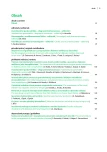Akromegaly and pharmacotherapy
Authors:
Helena Šiprová; Miroslav Souček
Authors‘ workplace:
II. interní klinika LF MU a FN u sv. Anny Brno, přednosta prof. MUDr. Miroslav Souček, CSc.
Published in:
Vnitř Lék 2015; 61(2): 157-160
Category:
Case Report
Overview
Acromegaly is a rare and serious disease. A successful and rational therapy of acromegaly ought to combine surgery, radiotherapy and pharmacotherapy. The submitted article presents a case of acromegaly that was only diagnosed at the stage when total pituitary adenoma removal was impossible. Even so, the long-term stabilisation of the disease was reached by way of repeated surgery through transfenoidal and transcranial approach, by linear accelerator radiation therapy and Leksell Gamma Knife radiotherapy and by pharmacotherapy with somatostatin analogon octreotide and growth hormone receptor antagonist pegvisomant. The octreotide and pegvisomant dosage has been repeatedly changed according to IGF1 levels. The contemporary somatostatin analogon Sandostatin LAR 30 mg is given once every 3 weeks and the growth hormone receptor antagonist Somavert 20 mg is applied daily. Despite this serious disease, the patient has already been living contentedly for 10 years. From the ethical point of view, the financials costingness of the therapy should be considered as reasonable.
Key words:
acromegaly – insulin-like factor 1 – octreotide – pegvisomant – pharmacotherapy – pituitary adenoma
Sources
1. Mercieca C, Gruppetta M, Vassallo J. Epidemiology, treatment trends and outcomes of acromegaly. Eur J Intern Med 2012; 23(8): 206–207.
2. Kršek M. Akromegalie a gigantismus. Postgrad Med 2011; 4 : 360–372.
3. Fernandez A, Karavitaki N, Wass JAH. Prevalence of pituitary adenomas: a community-based, cross-sectional study in Banbury (Oxfordshire, UK). Clin Endocrinol (Oxf) 2010; 72(3): 377–382.
4. Beckers A. Higher prevalence of clinically relevant pituitary adenomas confirmed. Clin Endocrinol (Oxf) 2010; 72(3): 290–291.
5. Wang JW, Li Y, Mao ZG et al. Clinical applications of somatostatin analogs for growth hormone-secreting pituitary adenomas. Patient Preference and Adherence 2014; 8 : 43–51.
6. Colao A, Ferone D, Marzullo P et al. Systemic complications of acromegaly: epidemiology, pathogenesis, and management. Endocr Rev 2004; 25(1): 102–152.
7. Davi MV, Carbonare LD, Guistina A et al. Sleep apnoea syndrome is highly prevalent in acromegaly and only partially reversible after biochemical control of the disease. Eur J Endocrinol 2008; 159(5): 533–540.
8. Lugo G, Pena L, Cordido F. Clinical manifestations and diagnosis of acromegaly. Int J Endocrinol 2012; 2012 : 540398. Dostupné z DOI: <http://doi: 10.1155/2012/540398>.
9. Andersen M. Management of endocrine disease: GH excess: diagnosis and medical therapy. Eur J Endocrinol 2014; 170(1): R31-R41.
10. Sala A, Ho KK. Growth hormone measurements in the diagnosis and monitoring of acromegaly. Pituitary 2007; 10(2):165–172.
11. Souček M (ed). Vnitřní lékařství. Vol 2. Grada: Praha 2011. ISBN 978–80–247–2110–1.
12. Brooke AM, Drake WM. Serum IGF-I levels in the diagnosis and monitoring of acromegaly. Pituitary 2007; 10(2): 173–179.
13. Tzanela M. Dynamic tests and basal values for defining active acromegaly. Neuroendocrinology 2006; 83(3–4): 200–204.
14. Marek J. Hypofyzární adenomy – kam směřuje léčba na počátku 21. století? Vnitř Lék 2010; 56(7): 690–694.
15. Guinto G, Abdo M, Zepeda E et al. Acromegaly: role of surgery in the therapeutic armamentarium. Int J Endocrinol 2012(2012): 306094. Dostupné z DOI: <http://dx.doi.org/10.1155/2012/306094>.
16. Sala E, Ferrante E, Locatelli M et al. Diagnostic features and outcome of surgical therapy of acromegalic patients: Experience of the last three decades. Hormones (Athens) 2014; 13(1): 95–103.
17. Rim CH, Yang DS, Park YJ et al. Radiotherapy for pituitary adenomas: long-term outcome and complications. Radiat Oncol J 2011; 29(3): 156–163.
18. Ježková J, Marek J, Hána V et al. Gamma knife radiosurgery for acromegaly-long-term experience. Clin Endocrinol (Oxf) 2006; 64(5): 588–595.
19. Liščák R, Ježková J, Marek J. Stereotactic radiosurgery of pituitary adenomas. Neurosurg Clin N Am 2013; 24(4): 509–519.
20. Giustina, A., Chanson P, Kleinberg D et al. Expert consensus document: A consensus on the medical treatment of acromegaly. Nat Rev Endocrinol 2014; 10(4): 243–248.
21. Marek J Současné možnosti a perspektivy léčby akromegalie. Čas Lék Čes 2014; 153(3): 131–136.
22. Espinosa de los Monteros AL, Carrasco CA, Albarrán AA et al. The role of primary pharmacological therapy in acromegaly. Pituitary 2014; 17(Suppl 1): S4-S10.
23. Caron PJ, Bevan JS, Petersenn S et al. Tumor Shrinkage With Lanreotide Autogel 120 mg as Primary Therapy in Acromegaly: Results of a Prospective Multicenter Clinical Trial. J Clin Endocrinol Metab 2014; 99(4): 1282–1290.
24. van der Lely AJ, Biller BM, Brue T et al. Long-term safety of pegvisomant in patients with acromegaly: comprehensive review of 1288 subjects in ACROSTUDY. J Clin Endocrinol Metab 2012; 97(5): 1589–1597.
25. Delemer B, Chanson P, Foubert L et al. Patients lost to follow-up in acromegaly: results of the ACROSPECT study. Eur J Endocrinol 2014; 170(5): 791–797.
Labels
Diabetology Endocrinology Internal medicineArticle was published in
Internal Medicine

2015 Issue 2
Most read in this issue
- Spontaneous bacterial peritonitis
- The examination of the small intestine by magnetic resonance imaging
- Empagliflozin – the new representative of SGLT2 transporter inhibitors for the treatment of patients with diabetes 2 type
- The importance of transcutaneous oxygen tension monitoring in diabetic patient with complications
